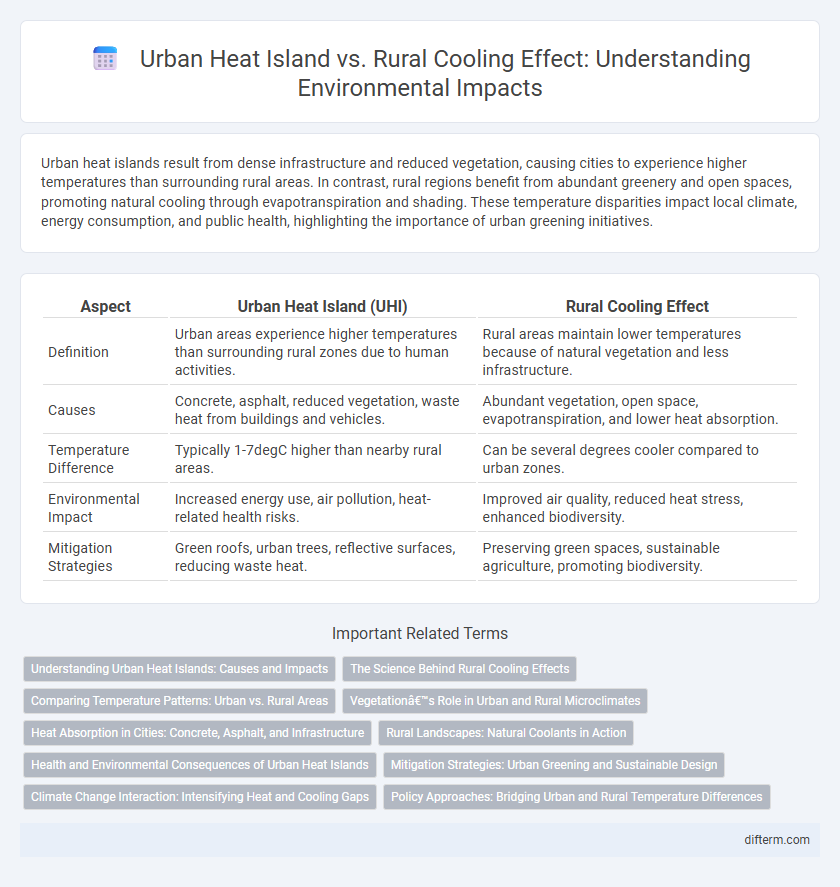Urban heat islands result from dense infrastructure and reduced vegetation, causing cities to experience higher temperatures than surrounding rural areas. In contrast, rural regions benefit from abundant greenery and open spaces, promoting natural cooling through evapotranspiration and shading. These temperature disparities impact local climate, energy consumption, and public health, highlighting the importance of urban greening initiatives.
Table of Comparison
| Aspect | Urban Heat Island (UHI) | Rural Cooling Effect |
|---|---|---|
| Definition | Urban areas experience higher temperatures than surrounding rural zones due to human activities. | Rural areas maintain lower temperatures because of natural vegetation and less infrastructure. |
| Causes | Concrete, asphalt, reduced vegetation, waste heat from buildings and vehicles. | Abundant vegetation, open space, evapotranspiration, and lower heat absorption. |
| Temperature Difference | Typically 1-7degC higher than nearby rural areas. | Can be several degrees cooler compared to urban zones. |
| Environmental Impact | Increased energy use, air pollution, heat-related health risks. | Improved air quality, reduced heat stress, enhanced biodiversity. |
| Mitigation Strategies | Green roofs, urban trees, reflective surfaces, reducing waste heat. | Preserving green spaces, sustainable agriculture, promoting biodiversity. |
Understanding Urban Heat Islands: Causes and Impacts
Urban heat islands (UHIs) occur when cities experience significantly higher temperatures than surrounding rural areas due to concentrated human activities, dense infrastructure, and limited vegetation. Materials like asphalt and concrete absorb and retain heat, intensifying local warming and exacerbating energy consumption, air pollution, and health risks. Understanding these causes helps in planning urban green spaces, reflective surfaces, and sustainable architecture to mitigate the UHI effect and promote cooler urban environments.
The Science Behind Rural Cooling Effects
Rural cooling effects stem from higher vegetation cover, increased soil moisture, and lower building density, which collectively enhance evapotranspiration and reduce surface heat absorption. These natural processes contribute to cooler temperatures compared to urban heat islands, where impervious surfaces and reduced greenery trap heat. Scientific studies highlight the critical role of vegetation in moderating microclimates, supporting biodiversity, and mitigating climate change impacts in rural areas.
Comparing Temperature Patterns: Urban vs. Rural Areas
Urban heat islands exhibit significantly higher surface and air temperatures compared to rural areas due to dense infrastructure, reduced vegetation, and heat-absorbing materials like asphalt and concrete. Rural regions experience a cooling effect driven by evapotranspiration from plants and open land cover, which lowers ambient temperatures and mitigates heat accumulation. Temperature data from satellite imagery consistently show urban centers with temperature increases of 1 to 7degC above surrounding rural landscapes, highlighting the stark contrast in thermal environments.
Vegetation’s Role in Urban and Rural Microclimates
Vegetation plays a critical role in mitigating urban heat island effects by providing shade, enhancing evapotranspiration, and reducing surface temperatures in urban microclimates. In contrast, rural areas benefit from extensive natural vegetation cover, which promotes effective cooling and maintains lower ambient temperatures through higher soil moisture and less heat absorption. The disparity in vegetation density and type directly influences the temperature differences between urban and rural environments, highlighting the importance of green infrastructure in urban climate regulation.
Heat Absorption in Cities: Concrete, Asphalt, and Infrastructure
Concrete, asphalt, and dense urban infrastructure significantly increase heat absorption in cities, contributing to the urban heat island effect by retaining and re-radiating solar energy. These materials have high thermal mass and low albedo, causing elevated surface temperatures compared to rural areas with vegetation and open soil. The lack of natural cooling through evapotranspiration in urban environments exacerbates heat buildup, intensifying temperature disparities between cities and surrounding rural zones.
Rural Landscapes: Natural Coolants in Action
Rural landscapes act as natural coolants by promoting evapotranspiration through dense vegetation and open soil surfaces, which lowers ambient temperatures significantly compared to urban areas. The presence of forests, grasslands, and water bodies in rural zones enhances heat dissipation and reduces the intensity of the urban heat island effect. These natural cooling mechanisms contribute to improved microclimates and biodiversity, mitigating climate stress in surrounding environments.
Health and Environmental Consequences of Urban Heat Islands
Urban heat islands significantly elevate ambient temperatures in cities, leading to increased heat-related illnesses such as heat exhaustion and heatstroke, particularly among vulnerable populations like the elderly and children. The amplified heat intensifies air pollution and ozone formation, exacerbating respiratory conditions including asthma and chronic obstructive pulmonary disease. Environmental consequences include accelerated energy consumption for cooling, heightened greenhouse gas emissions, and disrupted local ecosystems, worsening overall urban sustainability and public health risks.
Mitigation Strategies: Urban Greening and Sustainable Design
Urban greening initiatives, such as expanding parks, green roofs, and tree canopies, significantly reduce the urban heat island effect by enhancing evapotranspiration and providing shade. Sustainable design practices, including reflective building materials and green infrastructure, contribute to moderating urban temperatures and improving air quality. These mitigation strategies drive energy savings and foster healthier urban environments by counteracting heat accumulation typical of densely built areas.
Climate Change Interaction: Intensifying Heat and Cooling Gaps
Urban heat islands amplify local temperatures by absorbing and retaining heat through concrete and asphalt surfaces, while rural areas benefit from vegetation-driven cooling effects that moderate climate impacts. This disparity exacerbates climate change, intensifying heat stress in cities and widening thermal gaps between urban and rural regions. Mitigating urban heat islands through green infrastructure and reflective materials is crucial to reducing regional temperature extremes and improving resilience against global warming.
Policy Approaches: Bridging Urban and Rural Temperature Differences
Policy approaches to mitigate urban heat island effects emphasize integrating green infrastructure such as urban forests, green roofs, and permeable surfaces to enhance cooling and reduce energy consumption. Zoning regulations and land-use planning promote the preservation of rural areas and open spaces that support natural cooling processes, helping to maintain regional temperature balance. Incentives for sustainable development and cross-jurisdictional collaboration foster the implementation of temperature-moderating strategies that bridge urban and rural thermal disparities effectively.
urban heat island vs rural cooling effect Infographic

 difterm.com
difterm.com